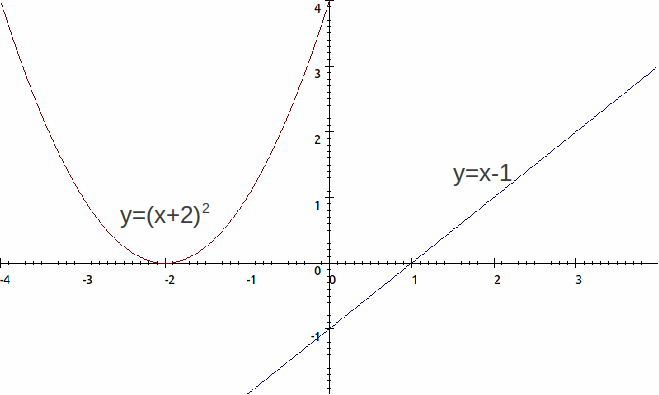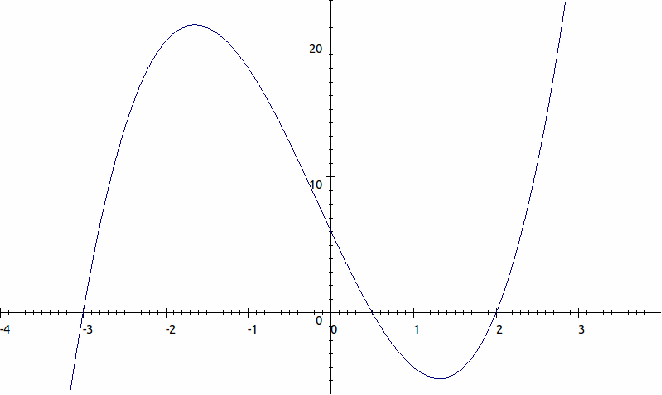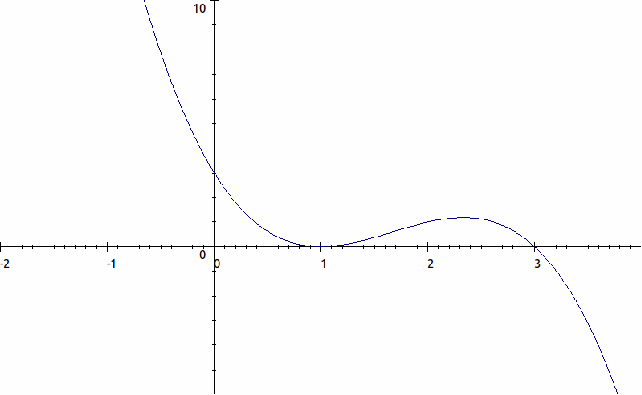When sketching curves of a polynomial function![]()
-
try to factorise it first, if it is not already factorised.Writing a polynomial as a product of factors -
 -for example - makes it easier to identify the roots – the pointswhere
-for example - makes it easier to identify the roots – the pointswhere Theroots will be points on the x – axis, since each root is asolution of the equation
Theroots will be points on the x – axis, since each root is asolution of the equation
-
Find the
 –intercept by substituting
–intercept by substituting into
into
-
Decide whether the curve tends to
 or
or asx tends to
asx tends to or
or Ifthe coefficient of the highest power of
Ifthe coefficient of the highest power of ispositive when the expression is expanded, then as
ispositive when the expression is expanded, then as  tendsto
tendsto sodoes
sodoes andif the coefficient is negative, then as
andif the coefficient is negative, then as tendsto
tendsto 
 tendsto
tendsto
-
Each distinct root -
 -with no power - will give rise to a point on the
-with no power - will give rise to a point on the –axis where the curve CROSSES the
–axis where the curve CROSSES the –axis, and each repeated root - given by a factor
–axis, and each repeated root - given by a factor – will give rise to a point on the curve which touches the
– will give rise to a point on the curve which touches the –axis but does not cross it if
–axis but does not cross it if iseven, or which forms a tangent to the
iseven, or which forms a tangent to the –axis and crosses it if
–axis and crosses it if isodd. Examples are shown below.
isodd. Examples are shown below.

For example, to sketch![]()
The roots are the solutions to![]()
These are
![]()
![]()
![]()
Substituting![]() intothe expression gives
intothe expression gives![]()
The highest power of![]() is
is![]() andthe coefficient of
andthe coefficient of![]() is2 (consider
is2 (consider![]() so
so![]() as
as![]()
Each root is distinct, so the graph crosses the![]() –axis at each root. The graph is sketch below.
–axis at each root. The graph is sketch below.

To sketch![]()
The roots are given by
![]()
![]()
Substituting![]() intothe expression gives
intothe expression gives![]()
The highest power of![]() is
is![]() andthe coefficient of
andthe coefficient of![]() is-1 (consider
is-1 (consider![]() so
so![]() as
as![]()
The root at![]() isa double root, so the curve touches the
isa double root, so the curve touches the![]() axisat
axisat![]() butdoes not cross it, and the root at
butdoes not cross it, and the root at![]() isa single root so the graph crosses the
isa single root so the graph crosses the![]() –axis there.
–axis there.
The curve is sketched below.

